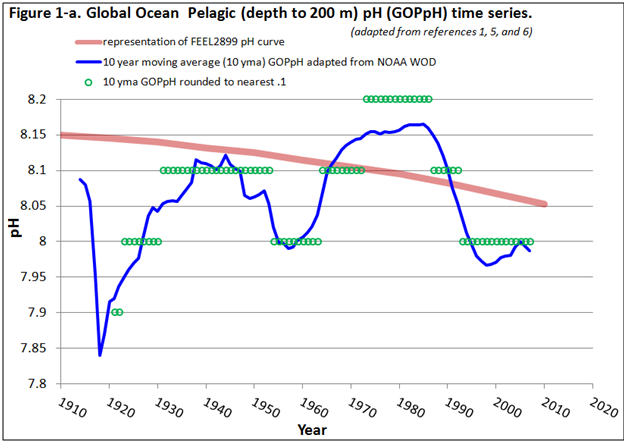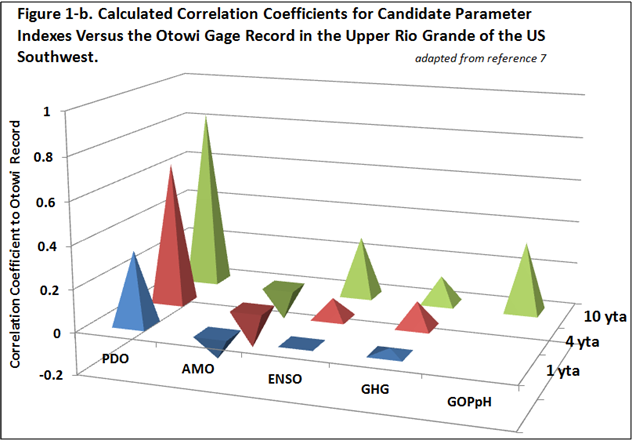WUWT - Watts Up With That
Testimony before Congress was based on model hindcast, actual data ignored
Guest essay by Michael Wallace, Hydrologist
Members of the global science and lay communities have begun to learn of the confirmed omission of 80 years of instrumental data from contemporary ocean acidification (OA) scientific products. The missing ~2 million data points comprise a majority of the world’s historical ocean pH measurements. The data was replaced without disclosure, by a model hind cast. The substituted history, known as the FEEL2899 report (1) was itself used as the technical basis for testimony to the US Congress (2). In turn, OA mitigation research funding was augmented, and the regulation of anthropogenic greenhouse gas (GHG) emissions was strengthened and deepened.
This occurrence of a model-replacing-data-without-disclosure has few publicized precedents of this scale. Already some in media have chosen to headline this as a case of “pHraud” (3). Whatever it is called, a fundamental question remains whether or not this omission will ever be corrected. Currently the major obstacle to rapid correction appears to be a consensus among those in power, that ocean pH cannot (and could never) be instrumentally measured using any conceivable means for any conceivable ocean purpose by any conceivable scientist. Therefore those in power effectively assert that the world must put aside expectations of data accessibility and transparency, and accept the PMEL authors’ formerly undisclosed SeaCarb model hindcast replacement as the entire truth of past ocean pH.
I came into awareness of the ocean pH data omission myself, purely through research activities, which led to personal communications with the authors of the omission (4). I learned through two of those authors some facts concerning the origins, pervasiveness, and structure of the omissions.
Originally I had simply hoped to find somewhere a complete basic ocean instrumental pH time series data set, in order to compare to other ocean and climate indices of interest to me. Although it was a detour from my primary research, I found it necessary to begin to construct my own time series and geospatial products, based on the new information, obliquely brought to my attention by the PMEL authors towards the end of our communications, which I later downloaded.
I have continued to follow up through ongoing stochastic evaluations of the actual omitted instrumental data (5). I think this information largely speaks for itself and so I’ve adapted some of those evaluations for the attached figure. In addition I’ve traced some of the OA citation pathways in order to focus on the most likely reasons for the existing disconnects between the OA research community and the rest of the aqueous pH measuring communities.
One of the greatest disconnects relates to the question of instrumental measurement accuracy. In my communications with the FEEL2899 authors from the Pacific Marine Environmental Laboratory (PMEL), they asserted that instrumental ocean pH measurements prior to around 1988 were not sufficiently accurate (4).
Figure 1-a. includes a subset of the FEEL2899 pH time series product as the thick reddish curve. Some aspects of the NOAA World Ocean Database (WOD) (6) global ocean pelagic pH data (GOPpH) are plotted over the same time frame. These include the ten year moving average in blue, and a rounded version of that as open green circles. Please note that although there doesn’t appear to be a clear trend up or down, both of the WOD-based curves suggest an oscillatory behavior, over the period shown.
As a rough illustration, I have included the green open circles of Figure 1.a., which are simply the blue curve data rounded to the nearest 0.1 pH unit. The apparent oscillatory pattern of the more refined time series is preserved. This holds even though I’ve already severely restricted the pH range of that data set due to the 10 year averaging filter.
The real data continue to receive additional confirmatory support. For example, I have been profiling outside natural indexes which appear to correlate with the WOD GOPpH data set (5). These include the Pacific Decadal Oscillation (PDO) and the Otowi stream gage in the US Southwest. I’ve included part b. of Figure 1 to summarize some of those findings here (7). As shown, my construction of the GOPpH time series shows a higher correlation to a premier continental stream gage (the Otowi gage of the Upper Rio Grande in the US Southwest) than correlations of that gage to the El Niño – Southern Oscillation (ENSO), the Atlantic Multidecadal Oscillation (AMO), and atmospheric CO2 (from Mauna Loa Observatory).
In any case, given such reproducible and stochastically interesting outcomes for GOPpH, why do OA researchers consistently maintain that GEpH meters are insufficiently accurate for any conceivable ocean hydroclimatologic use? Why do they also assert that only spectrophotometric (SP) based pH meters are up to the claimed accuracy challenge?
These assertions appear to be largely based upon invalid referencing (8,9) to the document known as “SCOR Working Group 75″ (SCOR75) (10). The SCOR75 report contradicts those claims by clearly stating that “Under the best circumstances, the absolute value of pH is only known within 0.01 pH unit”. Moreover, it appears that the validity of SP based pH measurements is only supported when those measurements are backed up by, of all things, GEpH meter readings. In fact, one of the FEEL2899 authors has contributed to a report where this GEpH specification is repeated many times (8).
Perhaps even these inconsistencies are overshadowed by another twist; why do SP based pH measurements also require the use of conventional pH indicator dyes? Unlike typical applications for SPs, the emission or absorption of the target ion species (hydronium in this context) is not directly measured. Rather, the SPs in this context appear to be nothing more than expensive, exotic, titration- fed colorimeters.
The non-OA community might benefit to know of this pernicious limitation that all ocean scientists are now constrained to. Is it conceivable that if only for consistency, authorities soon will pressure the rest of us to abandon GEpH meters in favor of a technology that is no more accurate, yet exponentially more expensive and time consuming?
No doubt I have biases, but I believe that the scientific consensus will eventually condense around the omitted NOAA WOD GOpH data as the most practical and useful foundation for any credible and complete ocean pH time series analyses. It is amazingly rich and informative, and appears to align with many independent hydroclimatologic patterns and expectations.
The ocean pH data omission was an unprecedented and disturbing incident in the history of hydrological sciences. Only NOAA can likely correct this. That’s because NOAA contains the source of the problem (the FEEL2899 pH time series product) as well as its solution (the WOD database). To help resolve that paralyzing disorder, scientists and others may wish to consider signing a petition that I have authored at (11). It may seem overly prescriptive, but in some ways it merely asks that the ocean pH data omissions be corrected by NOAA, and that GOpH measurements follow the OA authorities’ own published guidelines.
REFERENCES
- Feely, R.A., C.L. Sabine, and V.J. Fabry, 2006, CARBON DIOXIDE AND OUR OCEAN LEGACY http://www.pmel.noaa.gov/pubs/PDF/feel2899/feel2899.pdf
- American Clean Energy and Security Act of 2009 U.S. House of Representatives Rept. 111-137 Part 1. 111th Congress. CRPT-111hrpt137.pdf
- For example: Noon, M. 2014 article at:http://www.cfact.org/2014/12/22/what-if-obamas-climate-change-policies-are-based-on-phraud/
- Wallace, M., 2013 PMEL & Pew Charitable Trust Communications transcript compiled by Wallace.https://dl.dropboxusercontent.com/u/100449329/June2013WallaceResponseToFeel2899EmailString.pdf
- Wallace, M. 2014 – present, pH and Ocean Acidification (13 posts), http://www.abeqas.com
- NOAA NODC Ocean Climate Laboratory http://www.nodc.noaa.gov/OCL/
- Wallace, M. 2014 draft paper parked at:https://www.academia.edu/9071357/The_Relative_Impact_of_the_Pacific_Decadal_Oscillation_Upon_the_Hydrology_of_the_Upper_Rio_Grande_and_Adjacent_Watersheds_in_the_Southwestern_United_States._3_4_5
- Dickson, A.G., Sabine, C.L. and Christian, J.R. (Eds.) 2007. Guide to best practices for ocean CO2 measurements. PICES Special Publication 3, 191 pp.
- Aßmann S., C. Frank, and A. Kortzinger, 2011, Spectrophotometric high-precision seawater pH determination for use in underway measuring systems. Ocean Science 7, 597-607
- Final Report of SCOR Working Group 75, 1992, Methodology for oceanic CO2 measurements. UNESCO technical papers in marine science
- http://www.ipetitions.com/petition/restore-the-worlds-ocean-ph-measurements



 RSS Feed
RSS Feed
